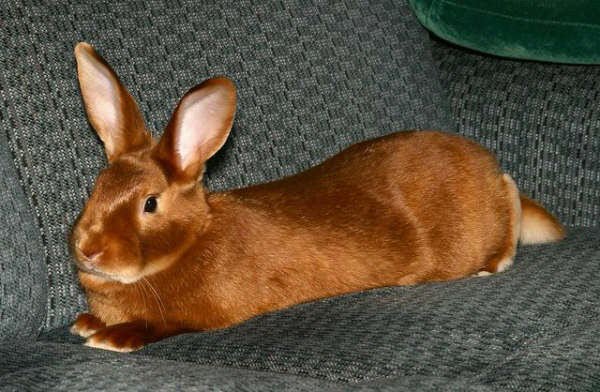Basic Appearance:
Satins are medium-large rabbits with commercial body type. They are named for their unique fur, which is very silky and has a bright sheen in natural light. Satin color is very bright. Satins have very good type with firm, well-fleshed bodies.
History, Temperament, and Common Uses:
The first rabbits with satin fur were born in 1934 in some Havana litters of Mr. Walter Huey, a rabbit breeder in the state of Indiana. He bred these satin Havanas back into his herd to improve his normal Havanas. When he started showing his satin Havanas other breeders didn’t think they should compete with the normal Havanas. For a while the American Federation of Havana Breeders sponsored the “satin Havanas” as a separate variety of their own breed. Eventually breeders across the country developed the satin breed we have today, and the American Satin Rabbit Breeders Association was formed in 1946. Satins were recognized by the ARBA in 1956, and are one of the top three commercial type breeds, after New Zealands and Californians.
Satins generally have a calm temperament, but this can depend on the lines they are from and if they are used to being handled.
Satins are striking and competitive show rabbits, their type has been developed to near perfection, with good topline and firm bodies. Being of commercial type, they also compete in meat classes such as Meat Pen and Fryer. But satins are not only show rabbits! They are a true multi-purpose breed. Satins are good meat rabbits, and are often raised to provide meat for the family table.
Grooming, Care, and Additional Notes:
As with other short-haired breeds, satins need little grooming. Simply brushing loose hairs off your rabbit’s coat with a soft brush or damp hands should have him looking his best. Satins will need more frequent grooming during a molt.
The high sheen of satin fur is produced by a recessive gene. It causes each hair to have a smaller diameter than that of normal fur, and also gives the hairs tiny air bubbles that catch the light. These two characteristics give satins their silky texture and gem-like shine.
Satin At A Glance…
Recognized Varieties:
Black, blue, broken group, Californian, chinchilla, chocolate, copper, otter, red, Siamese, and white.
ARBA Body Type:
Commercial
Approximate Size:
8 1/2 to 11 pounds.
Important Things to Look for When Buying Show Stock:
Satins should have commercial type with medium length of body. The depth of body should equal the width throughout. There should be a gradual taper from the widest point at the hindquarters to the slightly narrower shoulders. When viewed from the side the topline should start at the base of the ears and curve smoothly up to the highest point over the hindquarters. It should round down in a smooth curve to the base of the tail. The shoulders should be deep, the back, loin, and hindquarters full and rounded.
The head and ears should balance with the rest of the rabbit. Satins should have erect, well-furred ears. The eyes should be bright.
The legs should be straight and somewhat short with medium bone.
Look for fur that is very silky, fine, and dense. The soft, thick undercoat should be protected by guard hairs that are lustrous and provide good texture. When the fur is stroked against the grain it should return to its nature position and resume a smooth appearance. The entire coat should be even and have a distinct, glossy sheen.
Things to Avoid:
Narrow or flat shoulders or body. Shoulders wider than hindquarters. Flabby or narrow midsection. Protruding hips or spine. Flatness over hindquarters, or hindquarters chopped, pinched, or undercut. Flabby flesh condition.
Flyback fur, coarse or harsh fur, coat that is short, thin, or flat. Coat too soft or cottony, or will not return to proper position after being stroked backward. Fur lacking sheen will be disqualified.


